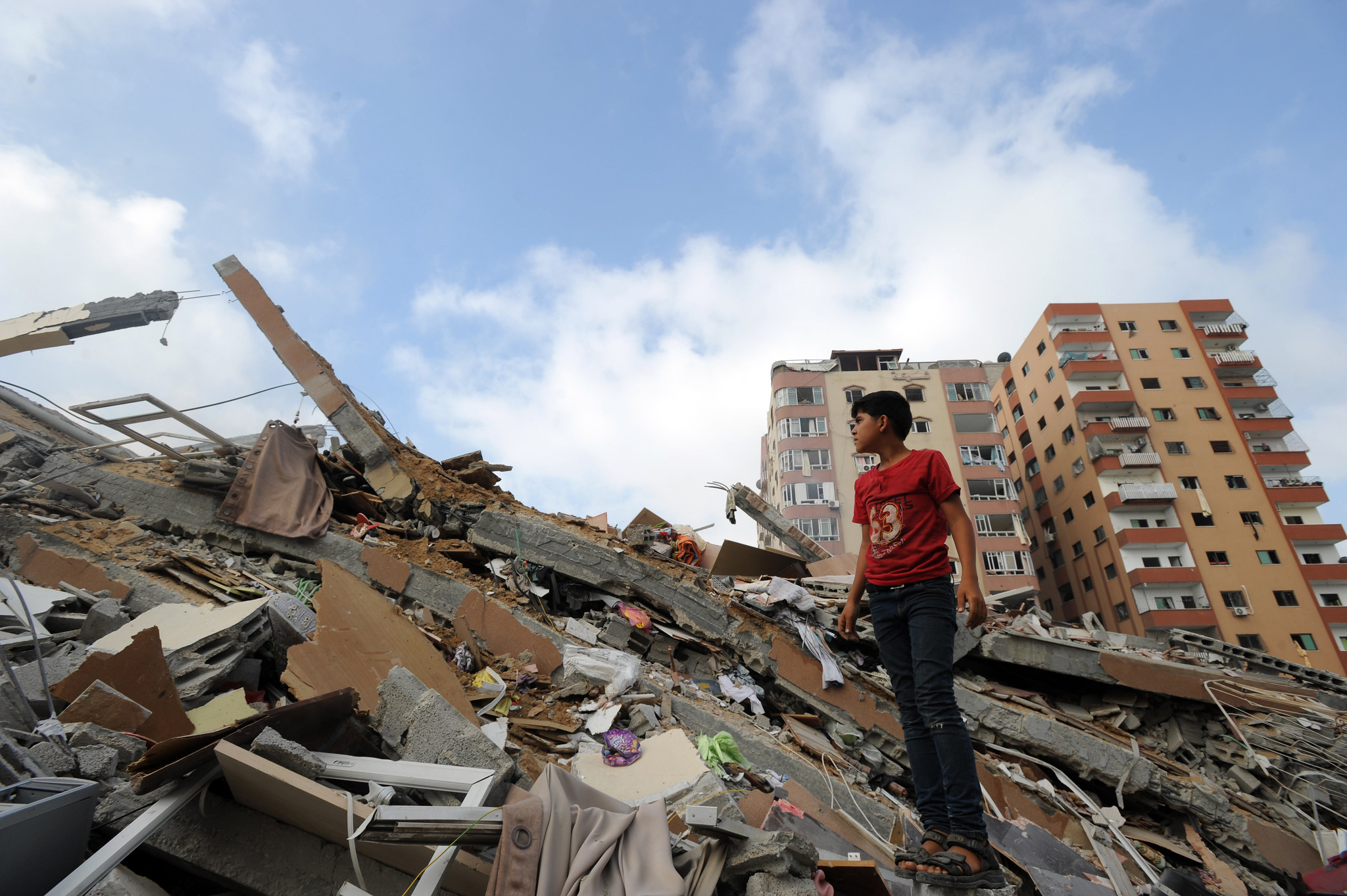This Is What the Death of the Two-State Solution Looks Like
The current unravelling has its roots in the political dysfunction of both Israel’s party system and the Palestinian national movement’s decayed one-party dictatorship.

Published by The Lawfare Institute
in Cooperation With

Editor’s Note: This article originally appeared on Order from Chaos.
The current crisis between Israelis and Palestinians in East Jerusalem, between Arabs and Jews in cities inside Israel, and between Israel and Hamas, is not analogous to any of the previous rounds of violence inflicted on Palestinian and Israeli civilians by their increasingly feckless and bankrupt political leaders. This is not another 2014, or another 2009, or another Second Intifada. It is something new. This is what the death of the two-state solution looks like.
The current unravelling has its roots in the political dysfunction of both Israel’s party system and the Palestinian national movement’s decayed one-party dictatorship.
But the precipitating event was the move by Israel’s government, last spring, to include annexation of West Bank territory in its coalition agreement, pending the resolution of the urgent COVID-19 pandemic.
For years, hardliners on both sides of the Israeli-Palestinian conflict, often including officials, have sought to erase or at least to blur the Green Line—the line that separated Israel from Jordan and Egypt before June 4, 1967, which is also the line that delineated Israel’s post-1967 occupation of the West Bank and Gaza. Officials erase the line from government and textbook maps, and activists wield slogans like “from the river to the sea,” or “no settlement is illegal.” Against such pressures, from 1993 until last year, stood the commitment of both Israeli and Palestinian leaders to negotiating an end to conflict through territorial compromise. Negotiated territorial compromise, more recently shorthanded as a “two-state solution,” is what extremists on both sides were pushing against with their expansionist policies, maps and slogans. And now, at last, they have succeeded.
The movement of Israeli political leaders in 2020—with the enthusiastic support of U.S. President Donald Trump—toward ending Israel’s Oslo commitment to negotiating territory and borders pushed the conflict to the edge of a precipice. The prospect of Israeli annexation of West Bank territory was another deep cut into the already tattered legitimacy of the Palestinian leadership in Ramallah, and it began to unravel the intricate web of Israeli-Palestinian security, economic and regulatory coordination in the West Bank. When annexation was put on hold in August 2020, some of that cooperation resumed. But the official Israeli abandonment of negotiated compromise, alongside continued settlement expansion and the forcible relocation of Palestinian families in East Jerusalem and communities in the West Bank, made a new crisis almost inevitable. It made inescapably obvious what was already clear to many: that the Oslo framework was exhausted, and the rationale for the prevailing order in the West Bank, including the existence of the Palestinian Authority, was defunct.
The 27 years since the Oslo Declaration in 1993, for better or worse, put boundaries around a conflict that had generated major wars in every decade since 1948, along with countless acts of international and cross-border terrorism and assassination. This is not to minimize what outlived Oslo. Those 27 years saw periods of military conflict and terrorist violence that cost thousands of Israeli and Palestinian lives, along with the entrenchment of Hezbollah and Hamas, continuous Israeli expansion of Jewish settlements and the Jewish population in the West Bank, and severe restrictions on the ability of Palestinian residents of the West Bank and Gaza to live lives free of structural violence. The Palestinian Authority, created by the Oslo Accords to hold a sublease on certain responsibilities of the Israeli occupation during the negotiating period, was corrupted by its cooperation with the occupation but also by its graft, infighting, lack of accountability and increasingly its repression and autocracy.
And still, throughout this period, the vision of a two-state solution, and the commitment of Israeli and Palestinian leaders—backed by the United States—to negotiate that compromise, also established a certain degree of clarity, predictability and constraint in relations between Israelis and Palestinians. The injustice and violence of occupation, in which about five million people, between the West Bank and Gaza Strip, lack either citizenship or self-determination, are daily features of this reality. And yet, until now we could not begin to understand what boundaries the formal commitment to a negotiated solution put around the behavior of the two communities living cheek-by-jowl in the land both claim as their own.
The different zones of the Israeli-Palestinian conflict evident this past month—in East Jerusalem, in the streets of Israeli cities, in Gaza and in the skies over Israel—reveal just how badly those boundaries in the conflict have been breached. Palestinians in East Jerusalem, in Lod, and in Gaza all hold very different status under Israeli law and policy. But in different ways, all of them are frustrated, even enraged, both at the obstreperous supremacy advanced by ideological Jewish activists against these Palestinians’ rights, freedoms and interests, and at the callously unequal treatment they receive at the hands of Israeli authorities. And in the wake of the riots and vigilantism in Jerusalem, Lod, Jaffa, Bat Yam and more, it’s also clear that too many Israeli Jews have come to see all of these Palestinians—whether fellow citizens or not—as their enemies.
The bankruptcy of political leadership on both sides is another reason why this crisis is so much worse, and so much more widespread, than previous episodes. Israel has held four elections in two years—and may now be on its way to a fifth, since coalition negotiations have been derailed by the violence and the political posturing around it. Prime Minister Benjamin Netanyahu’s “anti-solutionism” fuels regular rounds of crisis even as it enables him to retain his hold on power despite his simultaneous trial on corruption charges. And Palestinian President Mahmoud Abbas’s hold on power is likewise loosening—infighting within his own party torpedoed his plans for a new election that could have strengthened the legitimacy of his movement and his leadership. Instead, Hamas is able to use its rocket fire on Israeli civilians to usurp the narrative, to claim international attention and engagement, and likely also to win material benefits for itself and for Gaza Palestinians as part of an eventual ceasefire. And Israeli ministers can focus their narrative at home and abroad on defending Israeli civilians from Hamas attacks instead of the shredded fabric of Israeli society and the polarized dysfunction of its politics. This violence, redefined as another Israel-Hamas war, is all upside for the extremists and all downside for the forces of negotiated compromise and peaceful coexistence, both inside Israel and beyond the Green Line.
The latest escalation of violence demonstrates the folly of trying to marginalize this conflict for Israel, for its new Arab friends and for the Biden-Harris administration. They may all prefer to focus on cooperation in pursuit of what they see as higher priorities. But the current crisis threatens to overturn their fragile consensus, further destabilize a fragile region and divert the new U.S. administration’s attention from other foreign policy goals. And what we are now seeing, what Israelis and Palestinian civilians are now suffering, was more likely than not this year, as I noted in a Center for a New American Security report I published with Ilan Goldenberg and Michael Koplow in December.
A two-state outcome to the Israeli-Palestinian conflict is indeed a distant prospect—but the horrific alternative is now clear. It is time for leaders in Israel, in Palestine, in the region, and around the world to take that lesson to heart, and commit to assiduous efforts to get Israelis and Palestinians back on the long, arduous path toward a negotiated resolution.





